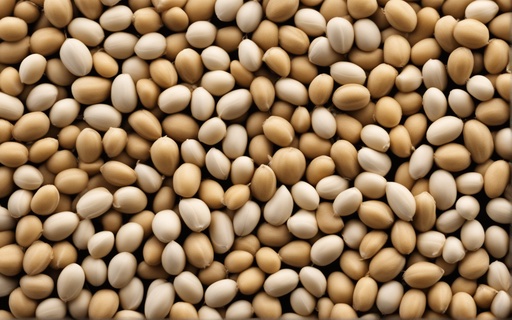Internet Asks: "Soybean Seed"
Soybean seeds, renowned for their versatility and nutritional value, are a staple in many diets and used in various products around the globe. This article seeks to provide insight into the features, nutritional profile, and uses of soybean seeds.
sponsored links

Botanical Profile
Soybean, scientifically known as Glycine max, belongs to the Fabaceae family. It is a leguminous plant native to East Asia. With a history tracing back thousands of years, it has been a staple in Asian diets and has eventually garnered popularity worldwide due to its nutritional prowess and multifaceted applications.
Physical Characteristics
- - Appearance: Soybean seeds are small, oval, and slightly flattened, possessing a smooth texture. They come in different colors, including yellow, green, brown, and black.
- - Composition: Each seed consists of two lobes enclosed by a hard hull. The lobes contain the germ and endosperm, with the germ being the active part that sprouts into a new plant.
- - Varieties: There are numerous varieties of soybeans, each with distinct characteristics. Some are cultivated for food production, while others are bred for oil extraction or use as animal feed.
Nutritional Overview
Soybean seeds are packed with a robust nutritional profile:
- - Protein: A standout source of plant-based protein, soybean seeds are essential for vegetarians and vegans. They contain all nine essential amino acids, making them a complete protein source.
- - Fats: While rich in fats, the majority of these are healthy polyunsaturated and monounsaturated fats.
- - Fiber: Soybeans are a good source of dietary fiber, beneficial for digestive health.
- - Vitamins & Minerals: Rich in various vitamins and minerals including B vitamins, Vitamin E, iron, and magnesium.
- - Isoflavones: Known for their antioxidant properties, isoflavones may also play a role in reducing the risk of certain diseases.
sponsored links
Agricultural Significance
Soybean seeds are one of the world's major crops, primarily because of their diverse applications:
- - Animal Feed: A significant portion of global soybean production goes into making soy meal, a prominent ingredient in animal feed.
- - Nitrogen Fixing: Soybean plants have the unique ability to fix nitrogen in the soil, enhancing its fertility. This characteristic makes soybeans an excellent crop for rotation, as they improve soil health for subsequent plantings.
- - Edible Products: Soybeans are processed into various food items, including tofu, tempeh, soy milk, and soy sauce.
- - Oil Production: Soybean seeds are a major source of vegetable oil, used for cooking and various food products.
- - Industrial Uses: Beyond food, soybean oil is utilized in making crayons, biofuels, solvents, and more.
Environmental Considerations
While soybeans have clear economic and nutritional benefits, their cultivation has environmental implications:
- - Land Use Change: Massive tracts of land, especially in regions like the Amazon, have been cleared for soybean cultivation, impacting biodiversity and contributing to deforestation.
- - Pesticide Use: Many soybean crops are genetically modified to resist pests or tolerate herbicides, which can have ramifications on local ecosystems and water sources.
Health Considerations
While soybeans are nutritious, some individuals might be allergic to soy and should avoid it. Furthermore, concerns about genetically modified (GMO) soybeans have spurred demand for organic and non-GMO options.
Conclusion
Soybean seeds are invaluable, offering nutritional benefits and versatility in various applications. From the dining table to industrial factories, these seeds play a crucial role in feeding populations and supporting various sectors. Understanding their features, nutritional content, and uses helps appreciate the significance of soybean seeds in our lives.
Disclaimer: The information provided in this article is for general informational purposes only and is not intended as medical or professional advice. Always consult with a healthcare or industry professional before making any decisions based on this content. For the most accurate and up-to-date health information, please consult authoritative sources and qualified health professionals.
sponsored links
References
1. Harvard T.H. Chan School of Public Health. Straight Talk About Soy. https://www.hsph.harvard.edu/nutritionsource/soy/
2. American Heart Association. Clearing up questions on whether tofu is healthy. https://www.heart.org/en/news/2022/10/10/clearing-up-questions-on-whether-tofu-is-healthy#:~:text=Nutritionally%2C%20tofu%20offers%20much%20to,alternative%20to%20animal%2Dderived%20meat.
3. Messina MJ. Legumes and soybeans: overview of their nutritional profiles and health effects. Am J Clin Nutr. 1999 Sep;70(3 Suppl):439S-450S. doi: 10.1093/ajcn/70.3.439s. PMID: 10479216.
4. NORTH CAROLINA SOYBEAN PRODUCERS ASSOCIATION. Uses of Soybeans. https://ncsoy.org/media-resources/uses-of-soybeans/#:~:text=Animal%20Feed%20Production,feed%20are%20fed%20to%20poultry.
5. Britannica. Soybean. https://www.britannica.com/plant/soybean
6. Michelfelder AJ. Soy: a complete source of protein. Am Fam Physician. 2009 Jan 1;79(1):43-7. PMID: 19145965.
7. U.S. DEPARTMENT OF AGRICULTURE. U.S. Soybean Production Expands Since 2002 as Farmers Adopt New Practices, Technologies. https://www.ers.usda.gov/amber-waves/2023/july/u-s-soybean-production-expands-since-2002-as-farmers-adopt-new-practices-technologies/
8. da Silva, R.F.B., Viña, A., Moran, E.F. et al. Socioeconomic and environmental effects of soybean production in metacoupled systems. Sci Rep 11, 18662 (2021). https://doi.org/10.1038/s41598-021-98256-6
People are also reading...
Seed Soybean
Is Tofu a Vegetable?
Soybean Miso
Are Carrots Acidic?
Is Truvia the Same as Stevia?
Whole30 What to Expect?
Does Hot Chocolate Have Caffeine?
Are Carrots Acidic?
Are Mangoes Acidic?
Orange Juice pH?
Does Kahlua Have Caffeine?
Calories In a Grilled Cheese?
Ready to level-up?
Create meal plans 10x faster, follow up with your clients through our mobile app, and never struggle with meal planning or recipe management again.